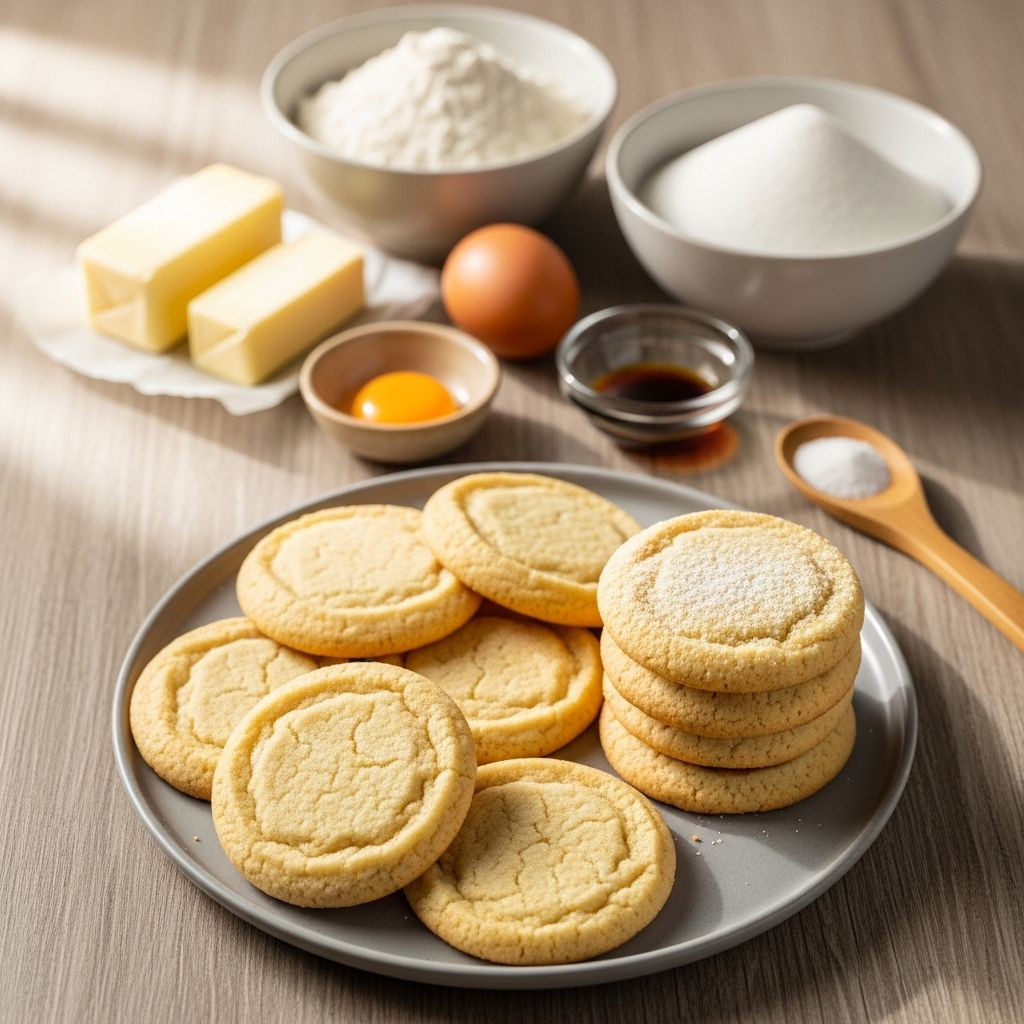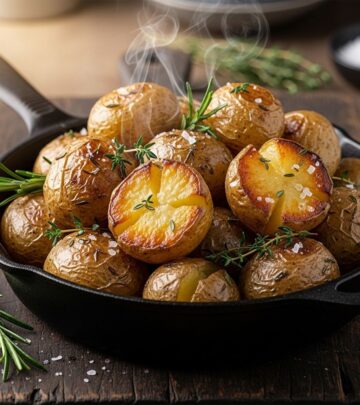Butter Cookies Recipe: 6 Easy Ingredients For Perfect Cookies
Discover the art of creating perfect butter cookies with this time-tested, versatile recipe

Image: HearthJunction Design Team
Classic Butter Cookies: Simple Ingredients, Endless Possibilities
There’s something undeniably comforting about the aroma of freshly baked butter cookies wafting through your home. These timeless treats strike the perfect balance between simplicity and sophistication—requiring just a handful of pantry staples yet offering endless possibilities for creativity. Whether you’re an experienced baker or a novice in the kitchen, this classic butter cookie recipe delivers consistently delicious results that will have everyone reaching for seconds.
What Makes Butter Cookies Special?
Butter cookies stand apart from other cookie varieties thanks to their rich, buttery flavor and versatile dough. Unlike sugar cookies, which often contain shortening, butter cookies rely heavily on high-quality butter for their distinctive taste and texture. The result is a cookie that’s simultaneously tender and crisp, with a melt-in-your-mouth quality that makes them irresistible.
While simple in ingredients, butter cookies can be transformed through various shaping methods, decorative techniques, and flavor additions. From classic rounds adorned with colorful sprinkles to intricately shaped cookies made with cookie presses, the possibilities are truly endless. This adaptability makes butter cookies perfect for everything from casual family gatherings to elegant holiday displays.
Essential Ingredients for Perfect Butter Cookies
The beauty of butter cookies lies in their simplicity. With just six basic ingredients, you can create cookies that taste far more complex than their recipe suggests. Here’s what you’ll need to gather before starting:
Ingredient List
- 1 cup (2 sticks) butter, softened to room temperature – The star ingredient that gives these cookies their name and distinctive flavor. For best results, use unsalted butter so you can control the salt content.
- 1 cup white sugar – Provides sweetness and contributes to the cookies’ structure.
- 1 large egg – Acts as a binder and adds richness to the dough.
- 2 teaspoons vanilla extract – Enhances the buttery flavor with warm, aromatic notes.
- 2 ⅓ cups all-purpose flour – Creates the structure of the cookies. Measuring accurately is crucial for consistent results.
- ¼ teaspoon salt – Balances the sweetness and enhances the overall flavor profile.
The quality of your ingredients matters significantly when making butter cookies. Since butter is the predominant flavor, opt for the best quality you can afford. European-style butter, with its higher fat content, creates an especially rich cookie. Similarly, using pure vanilla extract rather than artificial flavoring will yield a more nuanced taste.
Essential Equipment for Butter Cookie Success
Before diving into the baking process, ensure you have the necessary tools on hand:
- Electric mixer (stand or hand mixer) – For creaming butter and sugar effectively
- Mixing bowls – Various sizes for different stages of preparation
- Measuring cups and spoons – For accurate ingredient measurements
- Baking sheets – Preferably light-colored to prevent over-browning
- Parchment paper or silicone baking mats – For easy release and cleanup
- Cooling racks – To ensure cookies cool properly
- Cookie cutters or a cookie press (optional) – For creating shaped cookies
Step-by-Step Instructions
Follow these detailed instructions to create perfect butter cookies every time:
Preparation
- Preheat your oven to 350 degrees F (175 degrees C). Proper preheating ensures even baking.
- Prepare your baking sheets by lining them with parchment paper or silicone baking mats. This prevents sticking and makes cleanup easier.
Making the Dough
- Cream the butter and sugar: In a large bowl, beat the softened butter and white sugar with an electric mixer until light and fluffy, about 3-5 minutes. Don’t rush this step—proper creaming incorporates air into the mixture, resulting in better texture.
- Add the egg and vanilla: Beat in the egg and vanilla extract until completely incorporated and the mixture looks smooth.
- Incorporate dry ingredients: In a separate bowl, whisk together the flour and salt. Gradually add this mixture to the butter mixture, beating at low speed until just combined. Avoid overmixing, which can develop the gluten in the flour and make your cookies tough.
Shaping and Baking
- Shape the cookies: You have several options for shaping your butter cookies:
- Roll the dough into 1-inch balls and place on baking sheets, then flatten slightly with the bottom of a glass
- Roll out the dough to ¼-inch thickness and cut with cookie cutters
- Use a cookie press to create decorative shapes
- Form the dough into a log, chill, and slice into rounds
- Decorate (optional): Before baking, you can add sprinkles, colored sugar, or other decorations as desired.
- Bake the cookies: Place in the preheated oven and bake for 8-10 minutes, or until the edges are just barely turning golden. Butter cookies should not brown much—they’re done when they’re set but still pale.
- Cool properly: Allow cookies to cool on the baking sheet for 2-3 minutes before transferring to a wire rack to cool completely.
Tips for Butter Cookie Success
Even experienced bakers can benefit from these helpful tips:
- Temperature matters: Ensure your butter is properly softened—it should yield to gentle pressure but still hold its shape. Too cold, and it won’t cream properly; too warm, and your cookies will spread too much.
- Chill the dough: If your kitchen is warm or you’re experiencing spreading issues, refrigerate the dough for 30 minutes before shaping.
- Maintain uniform size: For even baking, make sure all your cookies are of consistent size and thickness.
- Rotate baking sheets: Halfway through baking, rotate your baking sheets 180 degrees to ensure even browning.
- Watch carefully: Butter cookies can go from perfectly baked to overdone quickly. Begin checking a minute before the suggested baking time.
- Store properly: Once completely cooled, store butter cookies in an airtight container at room temperature for up to a week. For longer storage, freeze for up to three months.
Creative Variations and Decorating Ideas
The versatility of butter cookie dough makes it perfect for customization. Here are some delicious variations to try:
Flavor Variations
- Citrus Butter Cookies: Add 1-2 teaspoons of lemon, orange, or lime zest to the dough for a refreshing twist.
- Almond Butter Cookies: Replace the vanilla extract with almond extract and sprinkle with sliced almonds before baking.
- Chocolate-Dipped: After cooling, dip cookies halfway in melted chocolate and sprinkle with chopped nuts or decorative sprinkles.
- Spiced Butter Cookies: Add ½ teaspoon of cinnamon or cardamom to the dry ingredients for a warm, aromatic flavor.
- Jam-Filled Thumbprints: Press an indentation in the center of each cookie before baking and fill with your favorite preserves.
Decorating Techniques
Elevate your butter cookies with these decorative touches:
- Royal Icing: Create intricate designs with colorful royal icing.
- Sandwich Cookies: Spread chocolate ganache, buttercream, or jam between two cookies for an indulgent treat.
- Colored Dough: Divide the dough and add food coloring to create multi-colored cookies.
- Rolling in Sugar: Before baking, roll balls of dough in colored sugar or cinnamon-sugar for a sparkling effect.
- Stenciled Designs: Use stencils and powdered sugar to create patterns on baked cookies.
Nutritional Information and Dietary Considerations
While butter cookies are undeniably a treat, it’s helpful to understand their nutritional profile. Each cookie (assuming a yield of approximately 36 cookies) contains roughly:
- Calories: 95-105 kcal
- Fat: 5-6g
- Carbohydrates: 11-12g
- Sugar: 5-6g
- Protein: 1g
Dietary Adaptations
For those with dietary restrictions, consider these adaptations:
- Gluten-Free: Substitute the all-purpose flour with a quality gluten-free baking blend. Add ¼ teaspoon of xanthan gum if your blend doesn’t already include it.
- Vegan: Replace butter with a plant-based butter alternative, and use a commercial egg replacer or 1 tablespoon of ground flaxseed mixed with 3 tablespoons of water per egg.
- Reduced Sugar: Cut the sugar by up to ¼ cup without significantly affecting texture. Consider adding an extra ¼ teaspoon of salt to enhance flavor.
Frequently Asked Questions (FAQs)
Q: Why are my butter cookies spreading too much?
A: Excessive spreading is typically caused by butter that’s too soft, overmixing the dough, or an oven temperature that’s too low. Try chilling your dough for 30 minutes before baking or increasing your oven temperature by 25 degrees.
Q: Can I make the dough ahead of time?
A: Absolutely! Butter cookie dough can be refrigerated for up to 3 days or frozen for up to 3 months. If frozen, thaw overnight in the refrigerator before shaping and baking.
Q: How do I know when butter cookies are done baking?
A: Butter cookies should be set but still pale when done. Look for very slight golden coloration at the edges. If they’re browning all over, they’re likely overbaked.
Q: Can I use salted butter instead of unsalted?
A: Yes, but omit the added salt in the recipe. Keep in mind that different brands of salted butter contain varying amounts of salt, which may affect the final taste.
Q: Why did my butter cookies come out tough?
A: Tough cookies usually result from overmixing the dough after adding the flour. Mix just until the flour is incorporated to prevent developing too much gluten.
Perfect butter cookies are within everyone’s reach with this foolproof recipe. The simple ingredients belie the complexity of flavor and the joy these cookies bring to both baker and eater. Whether you’re creating them for a special occasion or simply to satisfy a sweet tooth, these versatile treats are sure to become a staple in your baking repertoire. Happy baking!
References
- https://www.allrecipes.com/recipe/10011/butter-cookies-ii/
- https://www.allrecipes.com/recipes/15057/desserts/cookies/butter-cookies/
- https://www.allrecipes.com/recipe/25018/butter-rich-spritz-butter-cookies/
- https://www.allrecipes.com/recipe/25017/butter-cookies-v/
- https://www.allrecipes.com/recipe/25100/jam-filled-butter-cookies/
Read full bio of Shinta












